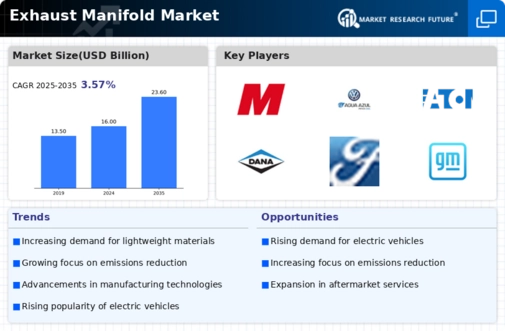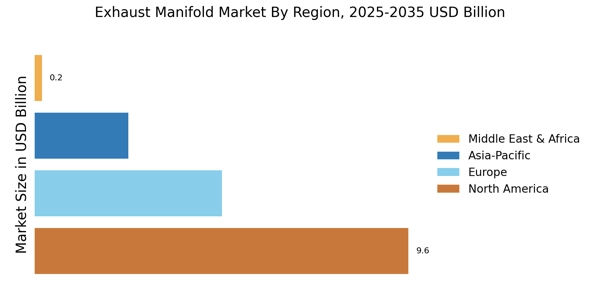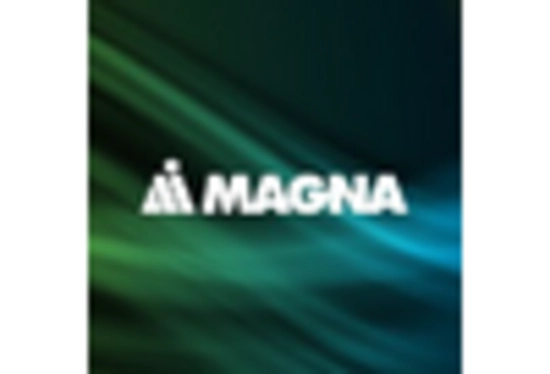Growth of the Automotive Industry
The overall growth of the automotive industry is a significant driver for the Exhaust Manifold Market. As vehicle production rates increase, the demand for exhaust systems, including manifolds, is expected to rise correspondingly. Recent statistics indicate that the automotive sector is projected to grow at a compound annual growth rate (CAGR) of approximately 5% over the next five years. This growth is attributed to rising disposable incomes, urbanization, and an increasing preference for personal vehicles. As more vehicles are produced, the need for efficient and reliable exhaust systems becomes paramount, thereby driving demand for exhaust manifolds. Additionally, the expansion of electric and hybrid vehicles, which still require exhaust systems for their internal combustion engines, further contributes to the growth of the Exhaust Manifold Market.
Increasing Demand for Fuel Efficiency
The rising emphasis on fuel efficiency in the automotive sector appears to be a primary driver for the Exhaust Manifold Market. As consumers become more environmentally conscious, manufacturers are compelled to innovate and produce vehicles that consume less fuel. This trend is reflected in the growing adoption of advanced exhaust manifold designs that optimize engine performance while minimizing emissions. According to recent data, the demand for fuel-efficient vehicles is projected to increase by approximately 20% over the next five years, thereby propelling the Exhaust Manifold Market forward. Furthermore, regulatory bodies are implementing stricter fuel economy standards, which further incentivizes manufacturers to invest in more efficient exhaust systems. Consequently, the market is likely to witness a surge in demand for exhaust manifolds that enhance fuel efficiency and comply with evolving regulations.
Rising Popularity of Performance Vehicles
The rising popularity of performance vehicles is emerging as a notable driver for the Exhaust Manifold Market. Enthusiasts and consumers are increasingly seeking vehicles that offer enhanced performance, which necessitates the use of high-performance exhaust systems. These systems often require specialized exhaust manifolds designed to optimize airflow and improve engine efficiency. Market trends indicate that the performance vehicle segment is expected to grow at a CAGR of around 7% in the coming years. This growth is likely to be fueled by advancements in automotive technology and a growing interest in motorsports. Consequently, manufacturers are focusing on developing exhaust manifolds that cater to this niche market, thereby stimulating growth within the Exhaust Manifold Market.
Regulatory Compliance and Emission Standards
The stringent regulatory compliance and emission standards imposed by various governments are a crucial driver for the Exhaust Manifold Market. As nations strive to combat air pollution and climate change, they are enacting laws that require automotive manufacturers to reduce harmful emissions from vehicles. This has led to an increased focus on the development of exhaust manifolds that can effectively manage and reduce emissions. For example, the implementation of Euro 6 standards in Europe has necessitated the use of advanced exhaust systems that can meet these requirements. Market analysis suggests that the demand for exhaust manifolds designed to comply with these regulations is expected to grow significantly, potentially increasing by 15% annually. Consequently, manufacturers are likely to prioritize the development of compliant exhaust systems, thereby propelling the Exhaust Manifold Market.
Technological Advancements in Manufacturing Processes
Technological advancements in manufacturing processes are significantly influencing the Exhaust Manifold Market. Innovations such as 3D printing and precision casting are enabling manufacturers to create more complex and efficient exhaust manifold designs. These technologies not only reduce production costs but also enhance the performance and durability of exhaust systems. For instance, the introduction of lightweight materials, such as aluminum and composite materials, is becoming increasingly prevalent, leading to a reduction in overall vehicle weight and improved fuel efficiency. Market data indicates that the adoption of advanced manufacturing techniques could potentially increase production efficiency by up to 30%. As a result, manufacturers are likely to invest in these technologies to remain competitive, thereby driving growth in the Exhaust Manifold Market.


















Leave a Comment